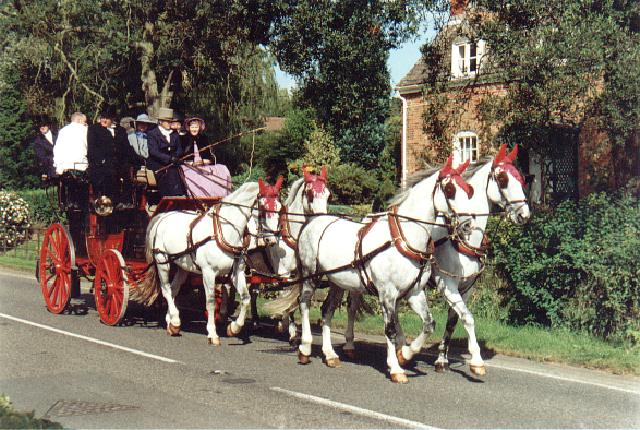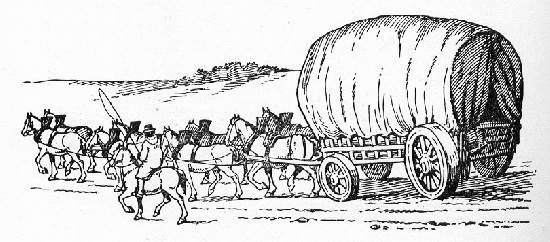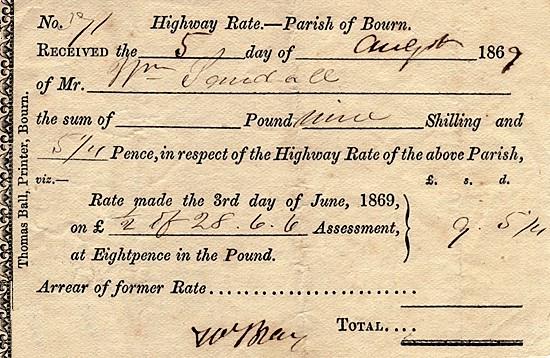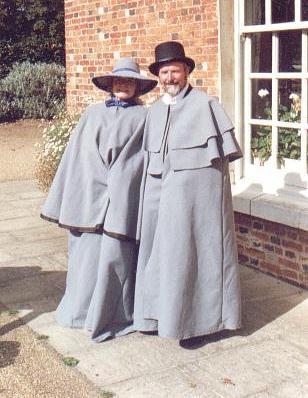|
Early
days on the road
|
 |
|
The Gay Gordon
stagecoach of 1832 with full complement of eleven passengers on
board, trotting through the Grimsthorpe village near Bourne in
September 2002, to discover what conditions on the road were like
for travellers during the 19th century. |
The stagecoach has a long association with Bourne because the town was on the main route between London and the north and so passengers travelling between London, Lincoln, York and even Scotland, passed through.
Both the Angel Hotel and the Bull Inn opposite [now the Burghley Arms] were well known posting house where the horses were stabled and travellers given overnight accommodation and records reveal that more than one baby was born there when lady passengers went into labour during the journey.
The roads became suitable for stagecoaches during the 18th century when the main highways through Bourne were brought under the care of turnpike trusts, as was happening in other parts of the country. The turnpike was a road having tollgates or bars on it, called turns, and these were constructed in the middle of the 18th century when interested farmers, landowners and businessmen subscribed among themselves for the repair of various roads and then recovered their outlay by extracting a toll for the privilege of using the
road. There was a popular resistance to the payment of tolls and this led to the passing of Acts of Parliament to regulate the system.
Better roads meant a rising popularity in wheeled transport and the movement of passengers long distances by stagecoach. The first coach in England was made by Walter Rippon for the Earl of Rutland in 1555 and nine years later he made one for Queen Elizabeth I. This mode of travel soon became popular and was much used as a public conveyance from the 18th century onwards but fares were high because the pace was slow. Passengers at first only travelled inside but outside seats at reduced rates were introduced to increase business and soon coaches were running on regular routes throughout the country, the faster, lighter vehicles being known as "flying coaches".
|
 |
|
By the early 19th century, stage wagons, such
as that pictured above in 1812, were being used to transport freight
and baggage between various destinations. At that time, the carriage
of goods per hundredweight (112 lb.) from London to Stamford and
Deeping was 5s. 6d, to Bourne 5s. 10d., to Grantham 6s., to Sleaford
and
Spalding 6s. 8d. and to Boston 7s. |
The Lincoln mail coaches, for instance, left the Great North Road at Peterborough, passing through Market Deeping, Baston and Bourne, and the Lincoln Flyer which operated between 1785 and 1871 had dark- blue painted bodywork with a canary yellow top section and the drivers wore long, yellow waistcoats to distinguish them.
In 1766, a coach left Bourne weekly to connect with the Stamford Flyer that would take passengers to London, inside at 18s. with 40lbs. of luggage, leaving at 10 o'clock at night and arriving in London the following morning. The Lincoln Flyer had a similar reputation. It left Lincoln at 2 pm and connected at Market Deeping with coaches from Stamford and Spalding with stabling for 100 horses at three local inns. The coach reached Peterborough at 9 pm and continued down the Great North Road to reach the Spread Eagle hostelry in Gracechurch Street, London, at 5 am next morning.
In 1743, eight stagecoaches passed through Market Deeping each day and
although this was the pick up point on several stagecoach routes, it never
had its own service based in the town. The Express called here as it
galloped between London and Barton-on-Humber, as did the Royal Mail coach
while The Perseverance stopped here on its journeys to and from London and
Boston and Jackson's stagecoach went through the town on its daily runs
between Boston and Stamford.
A daily service also passed through Bourne and in 1842,
for instance, a mail coach left the Bull Inn for
London at 7.20 pm each evening while one also ran in the opposite
direction leaving at 6 am bound for Hull. Another coach called The
Tally-ho ran between Lincoln and London, and calling at Bourne once daily
in each direction. The trip between the two centres took ten hours with
horses being changed every nine to 19 miles, according to the posting inns
on the route.
Stagecoach travel was uncomfortable and dangerous for
there was not only the risk of being robbed and even murdered by
highwaymen but the very act of travelling was risky, especially for
passengers travelling on the top who had to cling on for safety as the
coach negotiated uneven roads in all weathers including wind and rain,
snow and ice.
In 1825, an incident near Bourne illustrates just how risky it could be.
John Drummond was an outside passenger on the Lincoln Express coach
returning home to York on October 25th after a visit to London. The coach
was full both inside and out and having celebrated too lavishly before
leaving, there was a dreadful accident two miles out of Peterborough in
which he sustained fatal injuries. An inquest was held and the Stamford
Mercury reported on Friday 25th November: "It is feared that he was
somewhat inebriated. He fell asleep and suddenly awoke out of a terrific
dream which it is supposed startled the unfortunate man because he
instantly fell from the coach upon the ground whereby he sustained severe
injury, principally about the legs and thighs. The coachman and guard took
him forward to Bourne, a distance of 14 or 15 miles, where he was taken to
the Bull Inn [now the Burghley Arms] and thence to the workhouse: a
surgeon was called in but a mortification ensued about the third or fourth
day which terminated fatally." The coroner recorded a verdict of
accidental death.
There was also dangers for other road users and four
years later the Lincoln Express coach killed a man after running over him
as it was entering Bourne early on the morning of Sunday 15th February
1829. The coach was travelling at about 8 miles per hour and was heavily
laden as one of the wheels passed over the victim's shoulder and he died
soon afterwards.
In addition to the stagecoaches, a van left the Six Bells in North Street for London on three alternate days each week and a wagon once a week. Two carriers also operated local services to Stamford, Spalding, Sleaford, Peterborough, Grantham and Billingborough. When the railway began to penetrate the district, but before Bourne had its own rail connection, road services were introduced to link the town to the nearest available trains and by 1857, an omnibus was leaving the Angel Hotel every morning except Sundays at eight o'clock to connect with the railway station at Tallington on the Great Northern line. The carriers were now more numerous
than in 1842 and among them was George Pink who ran a van daily to Peterborough in connection with the railway company.
|
 |
|
Receipt for the Highway Rate levied in 1869
on Mr Willam Sandall, a farmer, of Thurlby, near Bourne. |
The use of stagecoaches for public travel began to decline with the coming of the railways in 1840 although it continued for many years afterwards in some rural districts that the permanent way had not yet reached, and as an amusement for the richer classes. But the expansion of the railways did not immediately reduce the number of local carriers and in 1896 there were still several
owners in Bourne operating weekly or twice-weekly services between the town and fourteen other towns and villages in the neighbourhood and several of these continued well into the 20th century until motor transport finally took over.
Stagecoach travel is now little more than an echo from years past but is still remembered and despite its obvious discomforts, continues to command a place in our affection through paintings, literature and films, as a symbol of an England long gone.
Those colourful days on the road were revived in the summer of 2002 with a series of stagecoach weekends in Lincolnshire. The refurbished 1832 Gay Gordon coach can carry eleven passengers and on selected Sunday mornings, leaves Grimsthorpe Castle for a round trip through the country roads to discover how things were in times past. The coach once trundled its way up and down the Great North Road between London and Edinburgh, a journey that took ten days and cost £10 first class, sitting inside the 4ft by 3ft wood-panelled cabin with room for six, or £3 10s. second class, sitting on top. It is owned and driven by Caroline Dale-Leech, whose father bought and restored it in the 1930s and now runs on regular trips from her Red House Stables Working Carriage Museum at Darley Dale in Derbyshire.
Fully loaded with passengers, it weighs four tons and is
pulled by four dappled greys, but demand for places is brisk and most of
the passengers turn up in period costume to add to the gaiety of the
occasion.
|
Among them for the inaugural outing of the Gay
Gordon coach on Sunday 8th September 2002 were Mrs Brenda Jones,
chairman of the Bourne Civic Society, and her husband Jim, who were
taking the trip to celebrate their wedding anniversary, both dressed
in Victorian costume, Brenda in poke bonnet and shawl and Jim in
cloak and stove pipe hat. "It was", said Jim afterwards, "a
memorable occasion and it might even be termed the trip of a
lifetime." |
 |
|
FROM THE ARCHIVES |
|
A pedlar was killed by the Lincoln Express
coach going over him near Bourne about 8 o'clock on Sunday morning.
The coach was going about 8 miles an hour, heavily laden, and
received a considerable shock by going over the body; one of the
wheels passed over the shoulder: the sufferer moaned once or twice
but died in a few minutes after being laid on top of the coach. No
blame is imputable to Bacon, the coachman. The deceased is known to
have been the subject of fits and might possibly have been lying in
the road in that state. Some of the passengers thought he had
probably been attempting to climb on the coach; and the more so as
the horses did not turn out of their track as is almost always the
case if a man be lying in their way. An inquest was held on the body
at Bourne workhouse on Monday by Samuel Edwards, gent., coroner,
when the verdict returned was that death had been occasioned in part
by the injury received from the coach and partly from a natural
cause, the deceased being known to have been for a long time in a
very diseased state. He was a travelling pedlar known by no other
name than John. - news report from the Stamford Mercury, Friday
20th February 1829. The Express coach
from Lincoln did not pass through Peterborough on Saturday morning
till 7 o'clock: the delay (of 2 hours) was caused by the terrific
effects of the lightning. When the coach was within a short distance
of Bourne, the electric flashes became so dreadful that in the
intervals, the passengers, coachman and guard seemed to be in total
and intense darkness and the horses were so paralysed that they
could not support themselves but fell flat on their sides, dragging
the coach over with them. In this state they remained for a
considerable time; but we are happy to state that no particular
injury was done and, of course, no blame could be attached to the
coachman. - news report from the Stamford Mercury, Friday 31st
July 1829. Jobson, the coachman of the Hull mail, was
found dead in his bed at Baldock yesterday morning. It appears that
he retired to rest in his accustomed health and spirits but on his
being called as usual yesterday morning, no answer being received,
his bedroom door was forced and he found a corpse. He was very much
respected and had left four orphan children at Bourne which he
considered his home. - news report from the Stamford Mercury,
Friday 14th October 1842. |
REVISED JUNE 2014
See also
Turnpike roads
The story of coachman
Joseph Brightmore

Go to:
Main Index Villages
Index
|



